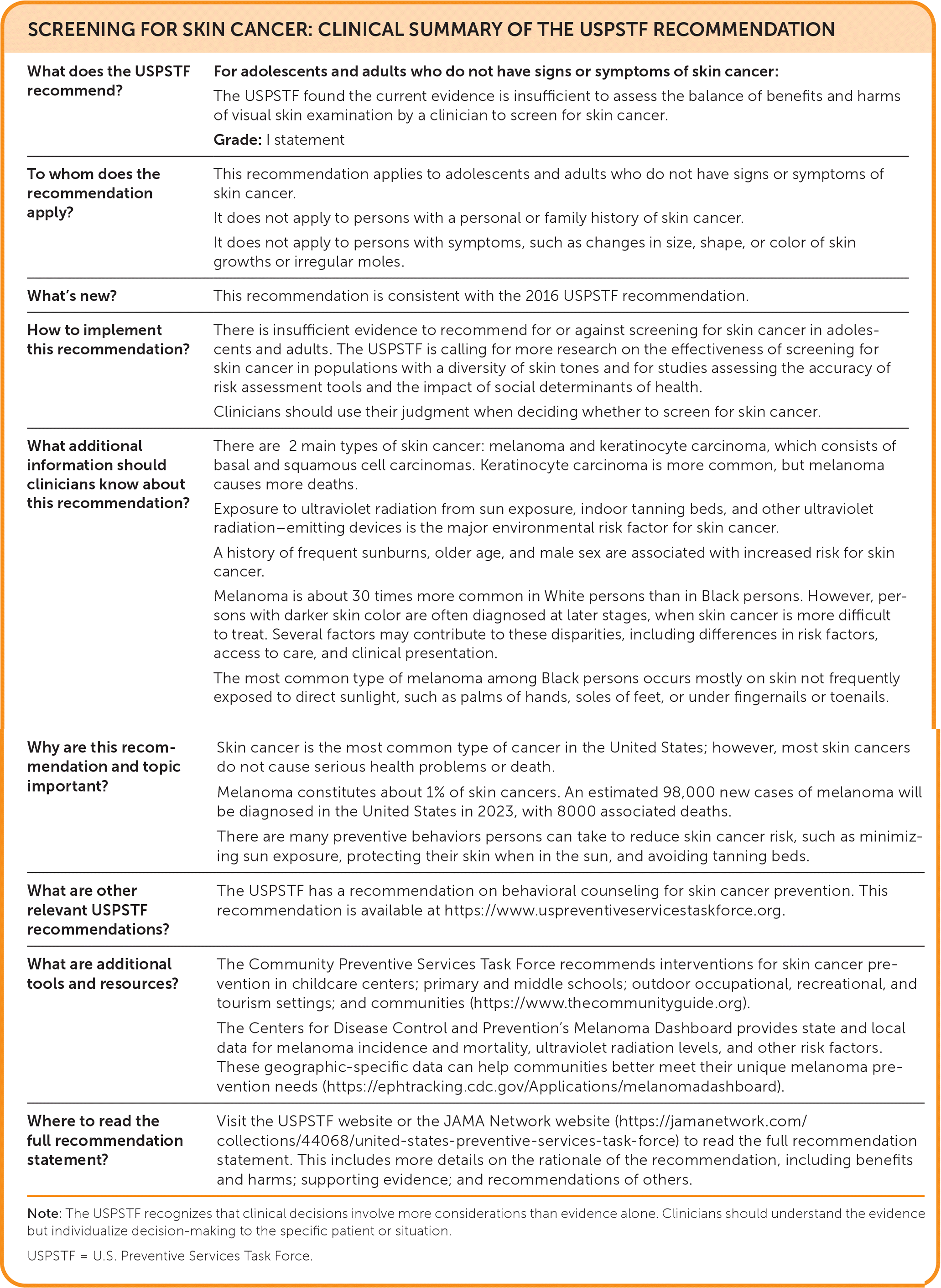
Am Fam Physician. 2023;108(1):online
As published by the USPSTF.

| What does the USPSTF recommend? | For adolescents and adults who do not have signs or symptoms of skin cancer: The USPSTF found the current evidence is insufficient to assess the balance of benefits and harms of visual skin examination by a clinician to screen for skin cancer. Grade: I statement |
| To whom does the recommendation apply? | This recommendation applies to adolescents and adults who do not have signs or symptoms of skin cancer. It does not apply to persons with a personal or family history of skin cancer. It does not apply to persons with symptoms, such as changes in size, shape, or color of skin growths or irregular moles. |
| What's new? | This recommendation is consistent with the 2016 USPSTF recommendation. |
| How to implement this recommendation? | There is insufficient evidence to recommend for or against screening for skin cancer in adolescents and adults. The USPSTF is calling for more research on the effectiveness of screening for skin cancer in populations with a diversity of skin tones and for studies assessing the accuracy of risk assessment tools and the impact of social determinants of health. Clinicians should use their judgment when deciding whether to screen for skin cancer. |
| What additional information should clinicians know about this recommendation? | There are 2 main types of skin cancer: melanoma and keratinocyte carcinoma, which consists of basal and squamous cell carcinomas. Keratinocyte carcinoma is more common, but melanoma causes more deaths. Exposure to ultraviolet radiation from sun exposure, indoor tanning beds, and other ultraviolet radiation–emitting devices is the major environmental risk factor for skin cancer. A history of frequent sunburns, older age, and male sex are associated with increased risk for skin cancer. Melanoma is about 30 times more common in White persons than in Black persons. However, persons with darker skin color are often diagnosed at later stages, when skin cancer is more difficult to treat. Several factors may contribute to these disparities, including differences in risk factors, access to care, and clinical presentation. The most common type of melanoma among Black persons occurs mostly on skin not frequently exposed to direct sunlight, such as palms of hands, soles of feet, or under fingernails or toenails. |
| Why are this recommendation and topic important? | Skin cancer is the most common type of cancer in the United States; however, most skin cancers do not cause serious health problems or death. Melanoma constitutes about 1% of skin cancers. An estimated 98,000 new cases of melanoma will be diagnosed in the United States in 2023, with 8000 associated deaths. There are many preventive behaviors persons can take to reduce skin cancer risk, such as minimizing sun exposure, protecting their skin when in the sun, and avoiding tanning beds. |
| What are other relevant USPSTF recommendations? | The USPSTF has a recommendation on behavioral counseling for skin cancer prevention. This recommendation is available at https://www.uspreventiveservicestaskforce.org. |
| What are additional tools and resources? | The Community Preventive Services Task Force recommends interventions for skin cancer prevention in childcare centers; primary and middle schools; outdoor occupational, recreational, and tourism settings; and communities (https://www.thecommunityguide.org). The Centers for Disease Control and Prevention's Melanoma Dashboard provides state and local data for melanoma incidence and mortality, ultraviolet radiation levels, and other risk factors. These geographic-specific data can help communities better meet their unique melanoma prevention needs (https://ephtracking.cdc.gov/Applications/melanomadashboard). |
| Where to read the full recommendation statement? | Visit the USPSTF website or the JAMA Network website (https://jamanetwork.com/collections/44068/united-states-preventive-services-task-force) to read the full recommendation statement. This includes more details on the rationale of the recommendation, including benefits and harms; supporting evidence; and recommendations of others. |
The full recommendation statement is available at https://www.uspreventiveservicestaskforce.org/uspstf/recommendation/skin-cancer-screening.
The USPSTF recommendations are independent of the U.S. government. They do not represent the views of the Agency for Healthcare Research and Quality, the U.S. Department of Health and Human Services, or the U.S. Public Health Service.
